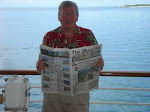 |
| This is one fast, sexy looking bird and lives next door to 817SP |
You say it's a P-51, and of course it is a P-51 - that's one of the most identifiable aircraft of World War II.
But wait, let's test your knowledge further, is it a P-51 A? Is it a P-51 B, or is it a C model? Now those who really know their planes will tell you this is a P-51D, because the A, B, and C all lacked the highly identifiable "bubble canopy".
 |
| Cavalier II Mustang, with Merlin V-12 engine |
Tip tanks were not in use during the second world war, but this was clearly a military P-51D. And there's a local connection too.
The year is 1957 (I'm ten years old, but know a P-51 from a P-40 as well as a P-38) and the last of the active duty P-51's have been pulled from Air National Guard service, with many released to the civilian market.
David Lindsay, a newspaper publisher, forms Trans Florida Aviation in Sarasota, to transform these former warbirds into well equipped and fast civilian business aircraft. He bought up surplus P-51s and added a second seat, updated the avionics, and installed a new tail (taller) vertical stabilizer with a laminar flow airfoil. He called these "Cavaliers". The plane, known for its ability to protect the bombers all the way to Berlin and back, was a logical choice for CEO's wishing a fast, long range (110 gallons on the Cavalier 2500) and plush. Lindsay renamed Trans Florida into Cavalier Aircraft and purchased the right to the P-51 from North American Aviation. He would gain Military Assistance Program money from the federal government and also convert P-51D's for several South American air forces. The Cavalier Mustang project ran its course, but not before one was modified from the Merlin V-12 engine to be powered by a Rolls Royce Dart 510 - at Lindsay's expense. The military here (USAF) and elsewhere were not interested, in this Turbo Mustang III, and Cavalier sold that project to Piper. Piper built two (2) PA-48 Enforcers, but they had little in common with the original P-51.


No comments:
Post a Comment